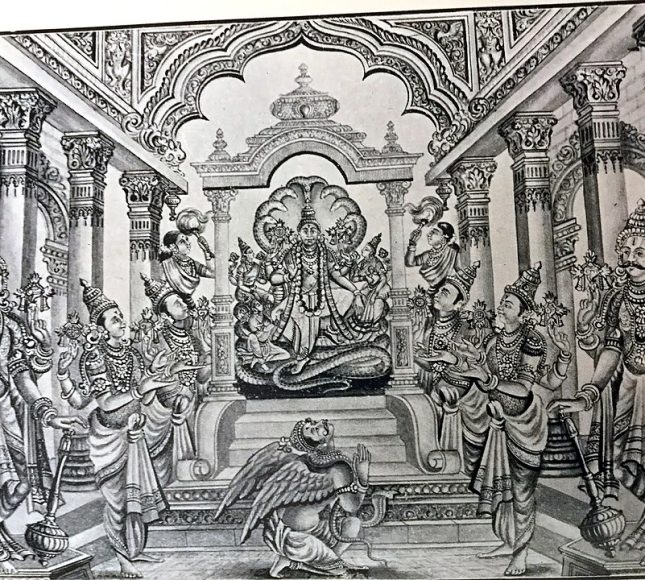BAIKUNTHA (VAIKUNTHA) Everyone talks of going there, but I do not know the situation of Baikuntha. They do not know their own secrets, they only mention Baikuntha in their talk. As long as the mind hopes to go to Baikuntha, till that time, it cannot abide at the Feet of the Lord. I do not know the temple of Baikuntha, its moat, citadel and the plaster. Except this what can we say, says Kabir, that only the Saab Sangat (congregation) is the Baikuntha.
(Bhairo Kabir, p. 1161) Wherever the saint puts his feet, there are sixty-eight pilgrim-stations; there is Baikuntha and the Name of the Lord is uttered there. (Ramkali M. 5, p. 890) The salvation and Baikuntha are there in Sadh Sangat, the man of God abides in the Abode of the Lord. (Dhanasari M. 5, p. 682) Baikuntha (Vaikuntha) is the heaven of Vishnu, said to be situated on Mount Meru. In Mahabharata it is stated that Vaikuntha is entirely made of gold.
Its circumference is eighty thousand miles. All the buildings are made of jewels. Vishnu is seated on white lotuses and Lakshmi sits on his right hand. The fragrance from her body spreads to eight hundred miles.The references given above state cleariy that for a man of God, the Vaikuntha is only Sadh Sangat or holy congregation, where the Name of the Lord is repeated and the Praises of the Lord are sung.
References :
1. Kohli, Surindar Singh, Dictionary of Mythological References in Guru Granth Sahib, 1993
Baikuntha
The Guru Granth Sahib, the central scripture and eternal Guru of Sikhism, is a repository of profound spiritual insights and universal wisdom. It draws upon various cultural and mythological references to convey its teachings in a way that transcends boundaries. One such reference is Baikuntha, a term from Hindu tradition often associated with the abode of Lord Vishnu, a paradise of eternal peace and liberation.
In Hindu mythology, Baikuntha represents a celestial realm where souls find freedom from the cycle of birth and death (samsara). It is depicted as a place of divine harmony, presided over by Vishnu, where ultimate liberation (moksha) is achieved. In the Guru Granth Sahib, however, the concept of Baikuntha is redefined to align with the Sikh philosophy of internal spiritual enlightenment rather than the pursuit of external paradises.
The scripture emphasizes that true liberation does not lie in reaching a physical or otherworldly realm but in realizing the divine presence within. Guru Nanak Dev Ji and the other contributors to the Guru Granth Sahib encourage seekers to break free from the illusions of material attachment and ego by embracing Naam Simran (meditative remembrance of the Divine Name) and living a life of humility, compassion, and service.
Through its references to Baikuntha, the Guru Granth Sahib conveys that the ultimate state of bliss and union with the divine can be attained here and now. This interpretation resonates with the Sikh belief in mukti (liberation) as an achievable goal in this lifetime. The scripture transforms the idea of Baikuntha from a distant paradise into an inner state of peace and fulfillment, accessible through devotion and righteous living.
In conclusion, the Guru Granth Sahib’s mention of Baikuntha is not a call to seek an external realm but an invitation to discover the divine within oneself. By reinterpreting this mythological concept, the scripture inspires its followers to live a life of spiritual awareness, aligning with the eternal truth and achieving harmony with the Creator.



